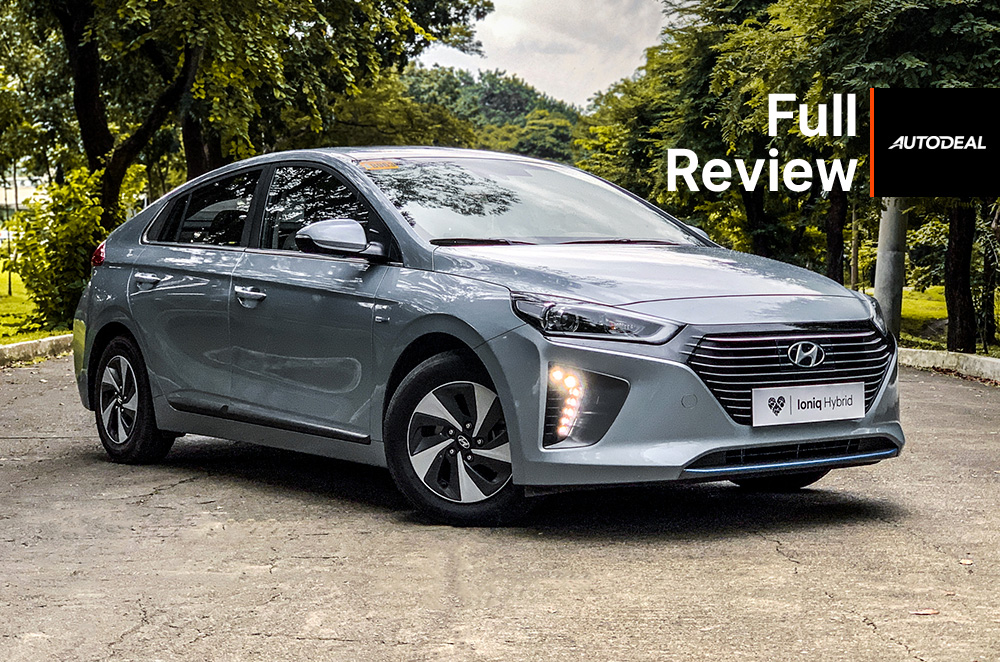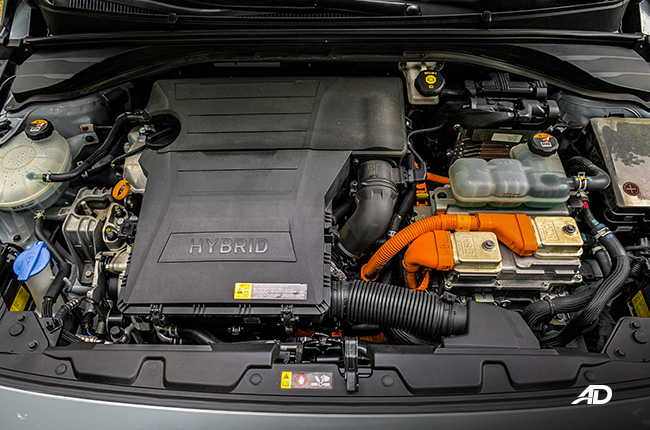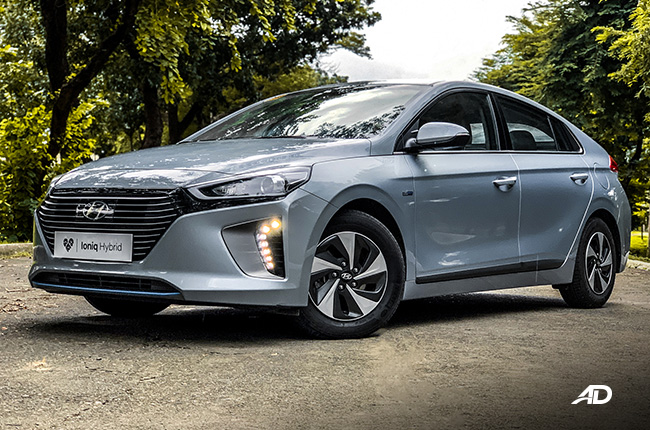
More for less. This is my biggest takeaway after driving the Hyundai Ioniq Hybrid for this review. You might be thinking: a non-sporty sedan that has a price tag of a decently-equipped SUV, how can that be more for less? Well, the answer lies in what comes with the car plus the very thing that makes parallel hybrid cars marketable – fuel savings.
The Ioniq Hybrid has been in the Philippines for a year now but it didn’t get the traction primarily because it’s new to ears of the many. With that, people have questions and that’s what I aim to answer in this full review.
Engine Output (HP), Acceleration, Transmission, Handling 4.0/5
Exterior & Interior Design, Quality, Fit and Finish, Ergonomics 4.0/5
Cabin Comfort, Suspension, NVH Insulation 4.5/5
Convenience Technologies, Active and Passive Safety Features 4.0/5
Amount of the vehicle you get for the price, Fuel Efficiency 4.0/5
- Outrageously frugal hybrid system.
- Outstanding ride comfort.
- Great handling for a front-wheel-drive vehicle.
- Scratchy piano black plastics on the base of the gear shifter.
- Head-room at the rear cabin's limited.
- Local-spec version needs more safety features.
Exterior
First things first: design. The Ioniq looks like a typical Hyundai but deviates a bit from the rest of the South Korean brand’s lineup. The cascading grille is wide, almost flanking the two sweptback projector LED headlamps. There are no fog lamps here, but dotted sets of LED daytime running lights. The Ioniq may look like a proper sedan upfront but in profile, the lifted rear end separates it from normal cars. When viewed from behind, the rear taillights look really good and the glass box you’ll see tells you that it’s a liftback, which adds a polarizing appeal.
Aside from the BlueDrive badge on the sides, the blue accents all over the car scream that this is a hybrid vehicle. They go well with the media units gray body color, but I’ve seen a black one on the road and it looks really good, I reckon. The 17-inch turbine-spoked wheels look okay but a bit timid.
Overall, I like the Ioniq Hybrid’s styling: different but not too conspicuous. But don’t take it from me – I have a taste for odd-looking cars. As looks will always be subjective, you’ll be the judge. What isn’t subjective is the solid fit and finish of the Ioniq’s body panels, which speaks about its build quality.
Interior
The great build quality transcends inside the Ioniq Hybrid. There are still plastic and polyurethane parts, yes, but they’re soft to the eyes and don’t look cheap at all. I specifically love the white leather seats as they match the light theme of the cabin and they’re soft to the touch. Other touchpoints like the elbow-rests are covered in leather, as well as the steering wheel and the gear-lever shifter. Controls are also clustered nicely, with tactile knobs to use, while the instrument cluster displays the right amount of information in an uncluttered manner. This is a huge plus for me, considering that this car’s a hybrid and one of the worries would be understanding what the digital gauge cluster is showing you. That’s not the case with the Ioniq Hybrid.
As a whole, the Ioniq’s cabin feels both premium and durable. It’s well thought out and logically designed. A bit of gripe, though – the base of the gear shifter has scratchy piano black plastics which could pose a problem in terms of aesthetic longevity.
Comfort
For its compact size, the Ioniq has a surprisingly massive cabin space that could seat up to five average-sized Filipinos. Three people would be a bit tight but possible. As a saving grace, the rear floor’s almost flat and the A/C vents work well in keeping the rear occupants cool. And, since this is a liftback (just like the Toyota Prius sans the hefty price tag), trunk space is cavernous but with a vertical limitation. Fold the seats flat to double the volume.
As for the driver, it’s easy to find a comfortable position because of several adjustments you can employ to the seat and steering column. There’s also a satisfying amount of bolstering, so it won’t be a tiring drive, even during longer ones. NVH’s quite insulated, too, and since this is a hybrid, the sound from the engine barely creeps in, if at all.
The Ioniq’s somewhat soft suspension setup (front McPherson struts and rear multi-link) and tall tire profile make for a comfortable ride. They work well in absorbing reasonable road imperfections, although there are instances when the impact is transferred into the cabin. On most parts, however, it’s pliant and coddles its passengers nicely.
Technology
You’ll never find the Ioniq’s tech toys lacking, but they’re not overflowing either. You get motorized seat adjustments for the driver, while speed-sensing door locks, automatic headlights, auto-dimming rearview mirror, and auto-folding side mirrors all come standard. The media tester comes with seat and steering wheel heaters but since this is a Korean-spec unit, I believe the local-spec version won’t have those as standard.
As for the head unit, the Ioniq Hybrid comes with a 5-inch touchscreen display at the center of the dashboard. The colors look nice, similar to what the Santa Fe has, plus it has Apple CarPlay and Android Auto for seamless smartphone pairing. It has a Qi wireless charger, too, as well as a rear parking assist system integrated with a camera.
Safety

In terms of safety, the local-spec Ioniq Hybrid felt lacking as it only comes with dual front, side, and curtain airbags as well as ABS, ISOFIX child seat tethers, front seatbelt reminders, and stability control. That’s about it. The blind-spot monitor and adaptive cruise control features aren’t included in the local-spec version of this compact hybrid car.
This makes me get jealous of Ioniq Hybrids that are available overseas, which come with autonomous emergency braking, adaptive cruise control, and other safety technologies. Then again, those things come with a price.
Driving & Handling

Let me get this out of the way – the Ioniq Hybrid doesn’t need to be plugged in to charge its battery. It uses a parallel hybrid system wherein the gasoline engine recharges the 1.56 kWh lithium-ion polymer battery that powers the permanent magnet synchronous motor. Combined, the hybrid system has a total output of 139 hp and 265 Nm torque.
With that said, the Ioniq Hybrid drives like a normal car, with a little bias on using the electric motors instead of the internal combustion engine. The car starts quietly, to the point that you’ll be able to leave your house without anyone noticing. In crawling traffic, you have a good 10-20 minutes of EV mode before the ICE starts interfering, which read back incredible fuel efficiency numbers – more on this below.

In terms of performance, the Ioniq Hybrid wasn’t a fast car, but as expected from an EV-biased hybrid system, instantaneous torque was available on tap and only on more spirited drives did I feel the need for the ICE’s help. The 6-speed dual-clutch transmission works seamlessly in the background, as well, with the option of manual override using the paddles. But the pull plateaued early even when the ICE started kicking in, which made the Ioniq a great daily commuter but an average highway cruiser.
Handling wasn’t perfect but it’s good for a front-wheel-drive vehicle. It's sturdy and composed, with a steering feel that changes with the car's speed. There were moments of body roll on tight corners but that’s understandable from a car that gears toward comfort. With the copious amount of glass panels, the Ioniq is also easily maneuverable in tight spaces as it didn’t feel quite wide. Braking, albeit all discs, felt a bit artificial because of the regenerative braking used to charge the batteries. Safe halting wasn’t compromised, nonetheless.
Fuel Economy

The icing of the cake or the cherry of the sundae is the Ioniq Hybrid’s fuel efficiency. An hour of crawling through EDSA returned 16.1 km/L – a number that most SUVs and pickup trucks will register on highway drives.
On Sunday strolls at around 60 km/h, I got 24.6 km/L, which also included sprints whenever there’s an opening. With the cruise control set at 90 km/h, the Ioniq Hybrid returned an unbelievable 30.1 km/L on the highway. If those numbers don’t impress you, I don’t know what else will.
Verdict

People are generally afraid of something new, something that they haven’t even tried. And they’re rightfully so – after all, who wants to spend his or her hard-earned cash for something that hasn’t proven anything yet, right?
But after this review and considering all the things you can get with the Ioniq Hybrid, the P1,548,000 price tag is well justified with its upscale and well-equipped interior, more-than-decent exterior design, and outrageously frugal hybrid system. With this in mind, you pretty much get more for less during the course of owning one, something that the pickiest car buyers should consider.
Maintenance
For those who are worried, I asked Hyundai Asia Resources, Inc. (HARI) a handful of questions concerning the maintenance of the Ioniq Hybrid’s powerhouse. According to the company, the lithium-ion polymer battery is covered by a 5-year warranty or 160,000 km, whichever comes first. It can also last up to eight years or 200,000 km. As for its PMS schedule, you will only need to service the Ioniq Hybrid every 7,500 km – equating to a P75,000 savings in five years.
However, HARI is yet to revert regarding the cost of replacing the battery if/when needed.
2019 Hyundai Ioniq Hybrid Exterior Photo Gallery
2019 Hyundai Ioniq Hybrid Interior Photo Gallery
Latest Review
-
Addictively excessive: The Ford Ranger Raptor Twin Turbo V6 / Review
The Ford Ranger Raptor Twin Turbo V6 is one crazy pickup truck. Wondering why? Just keep reading.
4.6 / 5 -
The Kia Carnival gives you more: More seats, more comfort, and more practicality / Review
The Kia Carnival is a three-row MPV designed for executives and families. It combines comfort, technology, and practicality, making it a strong choice for those looking for a premium people...
4.2 / 5 -
The Jetour Ice Cream: A pint-sized EV that’s hard to ignore / Review
The Jetour Ice Cream is an adorable, pint-sized electric car that’s made for the city. Affordable and stylish, it’s easy to love, but does it tick all the boxes for you?
3.7 / 5
Popular Articles
-
Cheapest cars under P700,000 in the Philippines
Jerome Tresvalles · Sep 02, 2024
-
First car or next car, the Ford EcoSport is a tough package to beat
Jun 18, 2021
-
Car Maintenance checklist and guide – here’s everything you need to know
Earl Lee · Jan 12, 2021
-
Most fuel efficient family cars in the Philippines
Bryan Aaron Rivera · Nov 27, 2020
-
2021 Geely Okavango — Everything you need to know
Joey Deriquito · Nov 19, 2020
-
Family cars in the Philippines with the biggest trunks
Sep 20, 2023
-
Head to head: Toyota Rush vs. Suzuki XL7
Joey Deriquito · Oct 28, 2020
-
Why oil changes are important for your car
Earl Lee · Nov 10, 2020
-
2021 Kia Stonic — What you need to know about it
Joey Deriquito · Oct 16, 2020
-
Top 7 tips for buying a used car in the Philippines
Joey Deriquito · Nov 26, 2020





















